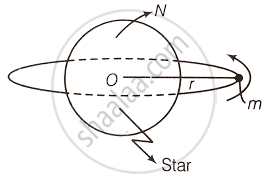Advertisements
Advertisements
Question
A star like the sun has several bodies moving around it at different distances. Consider that all of them are moving in circular orbits. Let r be the distance of the body from the centre of the star and let its linear velocity be v, angular velocity ω, kinetic energy K, gravitational potential energy U, total energy E and angular momentum l. As the radius r of the orbit increases, determine which of the above quantities increase and which ones decrease.
Solution
The situation is shown in the diagram, where a body of mass m is revolving around a star of mass M.

Linear velocity of the body `v = sqrt((GM)/r)`
⇒ `v ∝ 1/sqrt(r)`
Therefore, when r increases, v decreases.
Angular velocity of the body `ω = (2π)/T`
According to Kepler's law of the period,
`T^2 ∝ r^3` ⇒ `T = kr^(3/2)`
Where k is a constant
∴ `ω = (2π)/(kr^(3/2))` ⇒ `ω ∝ 1/r^(3/2)` .....`(∵ ω = (2π)/T)`
Therefore, when r increases, ω decreases.
The kinetic energy of the body,
K = `1/2 mv^2`
= `1/2 m xx (GM)/r`
= `(GMm)/(2r)`
∴ `K ∝ 1/r`
Therefore, when r increases, KE decreases.
The gravitational potential energy of the body,
`U = - (GMm)/r` ⇒ `U ∝ 1/r`
Therefore, when r increases, PE becomes less negative i.e., increases.
Total energy of the body,
`E = KE + PE`
= `(GMm)/(2r) + (- (GMm)/r)`
= `- (GMm)/(2r)`
Therefore, when r increases, total energy becomes less negative, i.e., increases.
Angular momentum of the body,
`L = mvr`
= `mr sqrt((GM)/r)`
= `msqrt(GMr)`
∴ `L ∝ sqrt(r)`
Therefore, when r increases, angular momentum L increases.
APPEARS IN
RELATED QUESTIONS
State Kepler's laws of planetary motion.
Answer the following question.
State Kepler’s law of equal areas.
Answer the following question in detail.
State Kepler’s three laws of planetary motion.
The third law of Kepler is also known as the Law of ______.
If the distance between the sun and the earth is made three times, then attraction between the two will ______
Both earth and moon are subject to the gravitational force of the sun. As observed from the sun, the orbit of the moon ______.
In our solar system, the inter-planetary region has chunks of matter (much smaller in size compared to planets) called asteroids. They ______.
The maximum and minimum distances of a comet from the Sun are 1.6 × 1012 m and 8.0 × 1010 m respectively. If the speed of the comet at the nearest point is 6 × 104 ms-1, the speed at the farthest point is ______.
lf the angular momentum of a planet of mass m, moving around the Sun in a circular orbit is L, about the center of the Sun, and its areal velocity is ______.
Two planets A and B of equal mass are having their period of revolutions TA and TB such that TA = 2TB. These planets are revolving in the circular orbits of radii rA and rB respectively. Which out of the following would be the correct relationship of their orbits?
